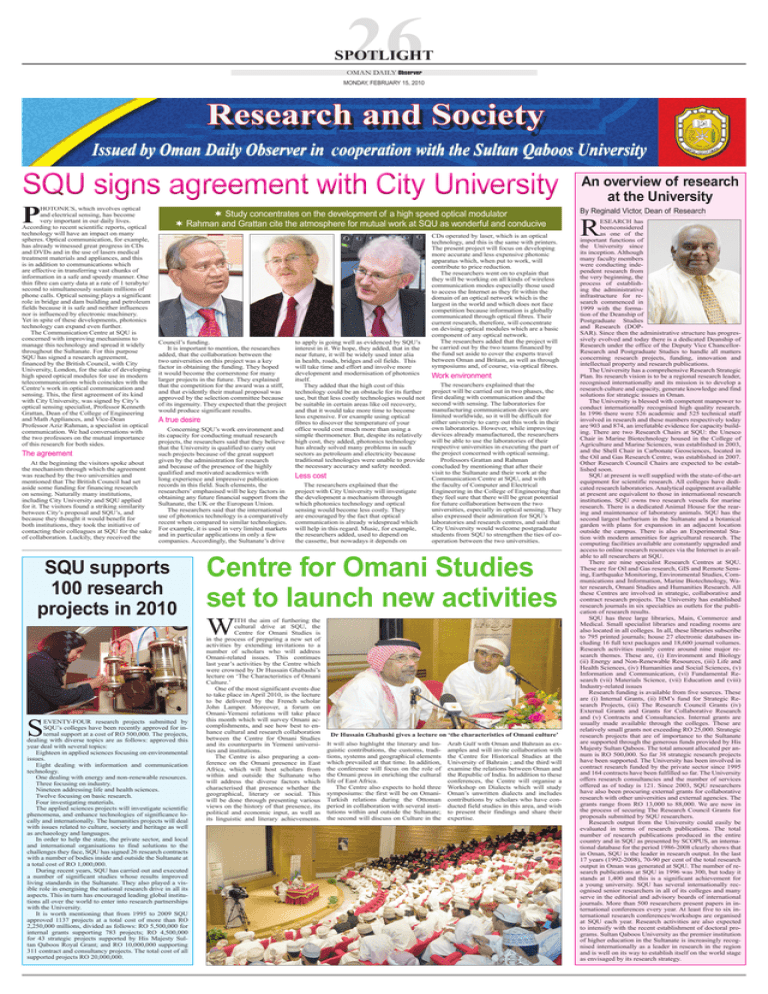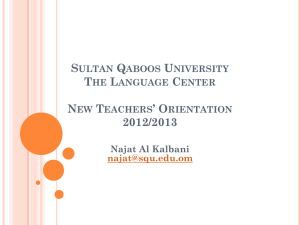26 Centre for Omani Studies set to launch new activities W
advertisement

26 SPOTLIGHT OMAN DAILY Observer MONDAY, FEBRUARY 15, 2010 SQU signs agreement with City University P hotonics, which involves optical and electrical sensing, has become very important in our daily lives. According to recent scientific reports, optical technology will have an impact on many spheres. Optical communication, for example, has already witnessed great progress in CDs and DVDs and in the use of lasers medical treatment materials and appliances, and this is in addition to communications which are effective in transferring vast chunks of information in a safe and speedy manner. One thin fibre can carry data at a rate of 1 terabyte/ second to simultaneously sustain millions of phone calls. Optical sensing plays a significant role in bridge and dam building and petroleum fields because it is safe and neither influences nor is influenced by electronic machinery. Yet in spite of these developments, photonics technology can expand even further. The Communication Centre at SQU is concerned with improving mechanisms to manage this technology and spread it widely throughout the Sultanate. For this purpose SQU has signed a research agreement, financed by the British Council, with City University, London, for the sake of developing high speed optical modules for use in modern telecommunications which coincides with the Centre’s work in optical communication and sensing. This, the first agreement of its kind with City University, was signed by City’s optical sensing specialist, Professor Kenneth Grattan, Dean of the College of Engineering and Math Appliances, and Vice-Dean Professor Aziz Rahman, a specialist in optical communication. We had conversations with the two professors on the mutual importance of this research for both sides. ¬ Study concentrates on the development of a high speed optical modulator ¬ Rahman and Grattan cite the atmosphere for mutual work at SQU as wonderful and conducive Council’s funding. It is important to mention, the researches added, that the collaboration between the two universities on this project was a key factor in obtaining the funding. They hoped it would become the cornerstone for many larger projects in the future. They explained that the competition for the award was a stiff, and that evidently their mutual proposal was approved by the selection committee because of its ingenuity. They expected that the project would produce significant results. A true desire Concerning SQU’s work environment and its capacity for conducting mutual research projects, the researchers said that they believe that the University is qualified to carry out such projects because of the great support The agreement given by the administration for research At the beginning the visitors spoke about and because of the presence of the highly the mechanism through which the agreement qualified and motivated academics with was reached by the two universities and long experience and impressive publication mentioned that The British Council had set records in this field. Such elements, the aside some funding for financing research researchers’ emphasised will be key factors in on sensing. Naturally many institutions, obtaining any future financial support from the including City University and SQU applied Sultanate, the UK or the European Union. for it. The visitors found a striking similarity The researchers said that the international between City’s proposal and SQU’s, and use of photonics technology is a comparatively because they thought it would benefit for recent when compared to similar technologies. both institutions, they took the initiative of contacting their colleagues at SQU for the sake For example, it is used in very limited markets and in particular applications in only a few of collaboration. Luckily, they received the companies. Accordingly, the Sultanate’s drive SQU supports 100 research projects in 2010 S eventy-four research projects submitted by SQU’s colleges have been recently approved for internal support at a cost of RO 500,000. The projects, dealing with diverse topics are as follows: approved this year deal with several topics: Eighteen in applied sciences focusing on environmental issues. Eight dealing with information and communication technology. One dealing with energy and non-renewable resources. Three focusing on industry. Nineteen addressing life and health sciences. Twelve focusing on basic research. Four investigating materials. The applied sciences projects will investigate scientific phenomena, and enhance technologies of significance locally and internationally. The humanities projects will deal with issues related to culture, society and heritage as well as archaeology and languages. In order to help the state, the private sector, and local and international organisations to find solutions to the challenges they face, SQU has signed 26 research contracts with a number of bodies inside and outside the Sultanate at a total cost of RO 1,000,000. During recent years, SQU has carried out and executed a number of significant studies whose results improved living standards in the Sultanate. They also played a visible role in energising the national research drive in all its aspects. This in turn has encouraged leading global institutions all over the world to enter into research partnerships with the University. It is worth mentioning that from 1995 to 2009 SQU approved 1137 projects at a total cost of more than RO 2,250,000 millions, divided as follows: RO 5,500,000 for internal grants supporting 783 projects; RO 4,500,000 for 43 strategic projects supported by His Majesty Sultan Qaboos Royal Grant; and RO 10,000,000 supporting 311 contract and consultancy projects. The total cost of all supported projects RO 20,000,000. to apply is going well as evidenced by SQU’s interest in it. We hope, they added, that in the near future, it will be widely used inter alia in health, roads, bridges and oil fields. This will take time and effort and involve more development and modernisation of photonics itself. They added that the high cost of this technology could be an obstacle for its further use, but that less costly technologies would not be suitable in certain areas like oil recovery, and that it would take more time to become less expensive. For example using optical fibres to discover the temperature of your office would cost much more than using a simple thermometer. But, despite its relatively high cost, they added, photonics technology has already solved many problems in such sectors as petroleum and electricity because traditional technologies were unable to provide the necessary accuracy and safety needed. Less cost The researchers explained that the project with City University will investigate the development a mechanism through which photonics technology and optical sensing would become less costly. They are encouraged by the fact that optical communication is already widespread which will help in this regard. Music, for example, the researchers added, used to depend on the cassette, but nowadays it depends on CDs operated by laser, which is an optical technology, and this is the same with printers. The present project will focus on developing more accurate and less expensive photonic apparatus which, when put to work, will contribute to price reduction. The researchers went on to explain that they will be working on all kinds of wireless communication modes especially those used to access the Internet as they fit within the domain of an optical network which is the largest in the world and which does not face competition because information is globally communicated through optical fibres. Their current research, therefore, will concentrate on devising optical modules which are a basic component of any optical network. The researchers added that the project will be carried out by the two teams financed by the fund set aside to cover the experts travel between Oman and Britain, as well as through symposiums and, of course, via optical fibres. Work environment The researchers explained that the project will be carried out in two phases, the first dealing with communication and the second with sensing. The laboratories for manufacturing communication devices are limited worldwide, so it will be difficult for either university to carry out this work in their own laboratories. However, while improving devices already manufactured, the researchers will be able to use the laboratories of their respective universities in executing the part of the project concerned with optical sensing. Professors Grattan and Rahman concluded by mentioning that after their visit to the Sultanate and their work at the Communication Centre at SQU, and with the faculty of Computer and Electrical Engineering in the College of Engineering that they feel sure that there will be great potential for future collaboration between the two universities, especially in optical sensing. They also expressed their admiration for SQU’s laboratories and research centres, and said that City University would welcome postgraduate students from SQU to strengthen the ties of cooperation between the two universities. Centre for Omani Studies set to launch new activities W ith the aim of furthering the cultural drive at SQU, the Centre for Omani Studies is in the process of preparing a new set of activities by extending invitations to a number of scholars who will address Omani-related issues. This continues last year’s activities by the Centre which were crowned by Dr Hussain Ghabashi’s lecture on ‘The Characteristics of Omani Culture.’ One of the most significant events due to take place in April 2010, is the lecture to be delivered by the French scholar John Lamper. Moreover, a forum on Omani-Yemeni relations will take place this month which will survey Omani accomplishments, and see how best to enhance cultural and research collaboration between the Centre for Omani Studies and its counterparts in Yemeni universities and institutions. The Centre is also preparing a conference on the Omani presence in East Africa, which will host scholars from within and outside the Sultanate who will address the diverse factors which characterised that presence whether the geographical, literary or social. This will be done through presenting various views on the history of that presence, its political and economic input, as well as its linguistic and literary achievements. Dr Hussain Ghabashi gives a lecture on ‘the characteristics of Omani culture’ It will also highlight the literary and linguistic contributions, the customs, traditions, systems and geographical elements which prevailed at that time. In addition, the conference will focus on the role of the Omani press in enriching the cultural life of East Africa. The Centre also expects to hold three symposiums: the first will be on OmaniTurkish relations during the Ottoman period in collaboration with several institutions within and outside the Sultanate; the second will discuss on Culture in the Arab Gulf with Oman and Bahrain as examples and will invite collaboration with the Centre for Historical Studies at the University of Bahrain ; and the third will examine the relations between Oman and the Republic of India. In addition to these conferences, the Centre will organise a Workshop on Dialects which will study Oman’s unwritten dialects and includes contributions by scholars who have conducted field studies in this area, and wish to present their findings and share their expertise. An overview of research at the University By Reginald Victor, Dean of Research R esearch has been considered as one of the important functions of the University since its inception. Although many faculty members were conducting independent research from the very beginning, the process of establishing the administrative infrastructure for research commenced in 1999 with the formation of the Deanship of Postgraduate Studies and Research (DOPSAR). Since then the administrative structure has progressively evolved and today there is a dedicated Deanship of Research under the office of the Deputy Vice ChancellorResearch and Postgraduate Studies to handle all matters concerning research projects, funding, innovation and intellectual property and research publications. The University has a comprehensive Research Strategic Plan. Its research vision is to be a regional research leader, recognised internationally and its mission is to develop a research culture and capacity, generate knowledge and find solutions for strategic issues in Oman. The University is blessed with competent manpower to conduct internationally recognised high quality research. In 1996 there were 526 academic and 525 technical staff involved in research and these numbers respectively today are 903 and 874, an irrefutable evidence for capacity building. There are two Research Chairs at SQU: the Unesco Chair in Marine Biotechnology housed in the College of Agriculture and Marine Sciences, was established in 2003, and the Shell Chair in Carbonate Geosciences, located in the Oil and Gas Research Centre, was established in 2007. Other Research Council Chairs are expected to be established soon. SQU at present is well supplied with the state-of-the-art equipment for scientific research. All colleges have dedicated research laboratories. Analytical equipment available at present are equivalent to those in international research institutions. SQU owns two research vessels for marine research. There is a dedicated Animal House for the rearing and maintenance of laboratory animals. SQU has the second largest herbarium in the Sultanate and a botanical garden with plans for expansion in an adjacent location outside the campus. There is also an Experimental Station with modern amenities for agricultural research. The computing facilities available are constantly upgraded and access to online research resources via the Internet is available to all researchers at SQU. There are nine specialist Research Centres at SQU. These are for Oil and Gas research, GIS and Remote Sensing, Earthquake Monitoring, Environmental Studies, Communications and Information, Marine Biotechnology, Water research, Omani Studies and Humanities Research. All these Centres are involved in strategic, collaborative and contract research projects. The University has established research journals in six specialties as outlets for the publication of research results. SQU has three large libraries, Main, Commerce and Medical. Small specialist libraries and reading rooms are also located in all colleges. In all, these libraries subscribe to 795 printed journals; house 27 electronic databases including 16 full text packages and 18,600 journal volumes. Research activities mainly centre around nine major research themes. These are, (i) Environment and Biology (ii) Energy and Non-Renewable Resources, (iii) Life and Health Sciences, (iv) Humanities and Social Sciences, (v) Information and Communication, (vi) Fundamental Research (vii) Materials Science, (vii) Education and (viii) Industry-related issues Research funding is available from five sources. These are (i) Internal Grants, (ii) HM’s fund for Strategic Research Projects, (iii) The Research Council Grants (iv) External Grants and Grants for Collaborative Research and (v) Contracts and Consultancies. Internal grants are usually made available through the colleges. These are relatively small grants not exceeding RO 25,000. Strategic research projects that are of importance to the Sultanate are supported through the generous funds provided by His Majesty Sultan Qaboos. The total amount allocated per annum is RO 500,000. So far 38 strategic research projects have been supported. The University has been involved in contract research funded by the private sector since 1995 and 164 contracts have been fulfilled so far. The University offers research consultancies and the number of services offered as of today is 121. Since 2003, SQU researchers have also been procuring external grants for collaborative research with other universities and external agencies. The grants range from RO 13,000 to 88,000. We are now in the process of securing The Research Council Grants for proposals submitted by SQU researchers. Research output from the University could easily be evaluated in terms of research publications. The total number of research publications produced in the entire country and in SQU as presented by SCOPUS, an international database for the period 1986-2008 clearly shows that in Oman, SQU is the leader in research output. In the last 17 years (1992-2008), 70-90 per cent of the total research output in Oman was generated at SQU. The number of research publications at SQU in 1996 was 300, but today it stands at 1,400 and this is a significant achievement for a young university. SQU has several internationally recognised senior researchers in all of its colleges and many serve in the editorial and advisory boards of international journals. More than 500 researchers present papers in international conferences every year. At least five to six international research conferences/workshops are organised at SQU each year. Research activities are also expected to intensify with the recent establishment of doctoral programs. Sultan Qaboos University as the premier institution of higher education in the Sultanate is increasingly recognised internationally as a leader in research in the region and is well on its way to establish itself on the world stage as envisaged by its research strategy.




